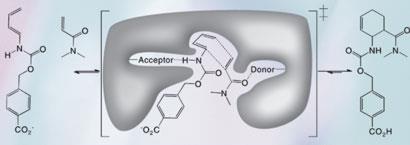US researchers create an artificial enzyme that can catalyse a reaction that, as far as we know, nature does not carry out
In a ground-breaking feat of protein engineering, US researchers have designed a synthetic enzyme that catalyses the Diels-Alder reaction - something that has not been seen in nature. The reaction is key to many organic syntheses and suggests that artificial enzymes could soon become part of the synthetic chemist’s toolkit.
Justin Siegel, from the University of Washington in Seattle, and colleagues chose as a model reaction the Diels-Alder cycloaddition of a diene and a dienophile to form a chiral cyclohexene ring.
’Using quantum chemical modelling and chemical intuition we can model the transition state of the reaction,’ says team member Alexandre Zanghellini. The key to catalysing the reaction is stabilising this transition with appropriately located hydrogen bonds. ’We put these hydrogen bonds in the relevant space then look through a library of proteins scaffolds to find candidates with the necessary characteristics,’ says Siegel.
An initial scan of 1019 protein structures identified some one million with potential active sites that fitted the bill. Further computational modelling reduced this figure to around 100 proteins - typically with about 300 amino acid residues - that looked promising.

Using genetic engineering techniques, these proteins were manufactured in bacteria in the laboratory. ’We then open up the bacteria, take out the proteins and put them in a test tube with our reactants to see if any of them work,’ says Siegel. Around 50 of the proteins were stable, and of these two catalysed the reaction.
The reaction occurs at around an order of magnitude slower than with metal catalysts, but with higher stereoselectivity and greater substrate specificity - the enzyme only wants to use a particular reactant.
’I think we are close to what would be needed in an industrial lab,’ says Zanghellini. The researchers say that improved activity should be possible by tweaking individual amino acids within the active site, and that it should be possible with other systems to introduce additional features such as artificial amino acids or metal centres.
’It is possible to envision extending nature’s repertoire by this approach,’ says Siegel. ’What we really want now is for other researchers to tell us which chemical reactions these enzymes could be good for - we are not chemists, we are protein engineers!’
Commenting on the work, computational enzymologist Adrian Mulholland, of Bristol University in the UK, says, ’This is an impressive achievement, using computational modelling to design a useful and novel protein catalyst for an unnatural chemical transformation. Together with other recent work by these researchers, this shows that the long-standing aim of designing protein catalysts for specific chemical applications is now a practically realisable goal.’
Simon Hadlington
References
J B Siegel et al, Science, 2010, DOI: 10.1126/science.1190239












No comments yet